#Principles Of Good Web Design
Explore tagged Tumblr posts
Text
0 notes
Text
What Is Truth (in game worldbuilding)
The question to start with: How do you present information as truthful in your world?
Okay, there’s a lot going on here, and it involves defining in order to get some specificity. The principles might be universalisable but I sure ain’t gunna pull it off here. This is primarily considering world-building for a game, and not the world-building for a conventional narrative explanation like a story or web serial or whatnot. Those are worlds where you can, amongst other things, go back in time and change the setup you have for the story you want.
And you should.
That’s what editing is.
But in the making of a world for a game, you have to make a way for people to interact with a playful space that gives them boundaries and things to interact with (that are cool and fun or ‘engaging’ if you want to be technical) and that means you need to confer the reality to these players in ways that you, the person building the world, may struggle with depicting.
The task of depicting truth is different in storytelling for a conventional narrative and for a game. Particularly, games have an interface layer that typically speaking, players have to have some reason to believe they can trust, and the job of the interface is to serve as a window between the reality of the game (ie, you are a player interacting with a playful device) and the fiction of the game (there are fuckin DRAGONS man).
See, one of the easiest ways to convey ‘true’ things to your players is to describe ideas in an entirely objective sense. This is this, this is that, and then you use objective measurements as much as you can, in the objective voice of a narrator. This is fine, this works out just okay, and I don’t want you to feel bad in any way about doing this this way, but when you present information like that, you have presented that information as reliable. That creates a sense of trust which you then can just poop down your leg when you have to explain that something you told them isn’t true.
Obviously you can be okay with this, I mean it doesn’t matter if a Metroidvania videogame has to indicate that an early message log was a lie. It needs to be done with a bit of care though because say, if a game opens by telling you that you’re using a stun gun to knock people out through the whole game, and then reveals, shock horror, that actually it’s a murder gun that has been knocking people into death with kill bullets, then the result isn’t going to be a player feeling an emotional distress at the realisation that they were doing something wrong because they trusted the wrong person, you’re going to have a player rejecting the experience, falling out of the fiction and going: this is bullshit.
(Because it is bullshit.)
I think on this because I think about how I present information from Cobrin’Seil. Cobrin’Seil is a D&D setting. It’s meant to be made for people to play in in a setting that is primarily mechanically oriented, where the world can be represented by reasonably reliably systems. Wizards in the top of the world and the bottom of the world can both cast spells that are similar and those spells may work differently under the hood, within the fiction, but are still reasonably coherently reliable things. The same is true that the followers of a death god can heal people with spells that may look entirely different to the spells of a god of the harvest but in the end, the people experiencing the outcome still wind up healed.
I think that the world of Cobrin’Seil is more interesting and more rewarding to write about if there is a strict delineation between the concrete and reliable — rules information — and the social and communicated — things people talk about in the world. That is to say, if you need to roll a few d6 or d8s for a thing, that’s rules information, segregated, and, thanks to 4th edition’s excellent trade dress (the way the books are designed to look) we have a good standardised way to express that. But if you want to know about the world, the things in the world and the way they relate to one another, then that’s where you talk to people and people have biases, and all the information presented in the world is presented as if it is being told to you by a person.
When I’m discussing the world of Cobrin’Seil, then, I know that it’s easy to state questions from a near-objective narrative position, but to deliver answers it should always have an attribution, a source. That source then gets to be someone potentially wrong, and to bring in their own biases and their own opinions.
I know that in Cobrin’Seil, I am biased towards presenting wizards who study things and write things down as a useful source of studyable information. I also know I don’t necessarily verify that information or make it widespread. Sometimes I like that because there are some things I want to be objectively true. For example: Wizards can prove that racism is based on nothing meaningfully true. On the other hand, that doesn’t mean people don’t believe in racism or engage in it, but that there is some objective authority in the universe that can say ‘look, this is a social system that sucks, and ‘detect racism’ spells won’t work.’
Otherwise, though? Things like how magic works? What gods can do? How fairies can manipulate reality? That stuff is all competing theories, maybes, possibilities, and I try to make sure it’s always at least three competing theories.
That bias remains, though, right? And it stands to reason, I, a person working in academia who is working on higher education, would likely see the advantages to and potential authority of a system like that. But that also demonstrates something of my biases towards, you know, things being written down. I could have it so that there are shamanic songs and lyrical poetry that carry important narratives of truth… except I’m not good at writing those, so I don’t.
This is what you need to be mindful of. There are ways to represent what’s ‘true’ in your worldbuilding, in the information you present to people, but you need to also be mindful of your biases. You need to maintain a sense of truth that players can engage with and you need to be mindful of where it’s okay to lie to them.
Check it out on PRESS.exe to see it with images and links!
74 notes
·
View notes
Text
Web designer in Jodhpur
Creative Web Design
We are a web designing company that has a team of skilled and experienced web designers and developers who can create stunning and functional websites for any type of business or domain. We offer a variety of web designing services, such as custom web design, web development, web hosting, SEO, and maintenance. We also provide you with a free web design consultation, where we can discuss your goals, needs, and preferences, and provide you with a web design proposal that suits your requirements and expectations.
What we do in Web Design
Our web designing services are the services that provide web designing solutions for clients who want to create or improve their online presence. It involves the use of various elements such as colours, fonts, images, graphics, animations, and interactions to convey the message and purpose of the website to visitors. Web designing services can help clients with various aspects of web designing, such as Consultation: Our web designing services can help clients understand their goals, needs, and preferences, and provide them with expert advice and guidance on how to achieve them . Strategy: Our services can help clients develop a clear and effective web design strategy that aligns with their brand identity, target audience, and business objectives.Design: We help clients create a unique and attractive web design that reflects their vision and personality, and that engages and impresses their visitors.Launch: Our services can help clients launch their website to the public, and provide them with web hosting, domain registration, and security services.
Our Design Technology
At Web Farm House, we understand that web design is not just about making a website look good. It is also about making it work well, communicate effectively, and provide value to the users. That is why we use the latest web design technology to create websites that are:
Visually appealing: We use web graphic design to create stunning and consistent visual elements for your website, such as colours, fonts, images, icons, and animations.
Easy to use: We use user interface design to create intuitive and interactive elements for your website, such as buttons, menus, forms, and navigation.
Functional and reliable: We use web development to code and program your website, using languages such as HTML, CSS, JavaScript, PHP, and others. We follow the principles of web standards, web accessibility, web performance, and web security, to ensure the quality and reliability of your website.
Our Work Process
At Web Farm House, we follow a systematic and collaborative work process to create your website. Our work process consists of four main phases: Discovery, Design, Development, and Delivery:
Discovery: This is the phase where we get to know you and your project. We will ask you some questions about your goals, needs, preferences, budget, and timeline. We will also conduct some research on your industry, competitors, and target audience. Based on the information we gather, we will create a project proposal and a contract for you to review and approve.
Design: This is the phase where we create the visual and interactive elements of your website. We will start by creating a sitemap and a wireframe, which are the blueprints of your website’s structure and layout. We will then create a mockup, which is a prototype of your website’s appearance and functionality. We will present the mockup to you and ask for your feedback and approval. We will make any revisions as needed until you are satisfied with the design.
Development: This is the phase where we code and program your website. We will use the latest web development technology to create a website that is functional, reliable, and compatible with different devices and browsers. We will also test and debug your website to ensure its quality and performance. We will show you the progress of the development and ask for your feedback and approval.
Delivery: This is the final phase where we launch and maintain your website. We will upload your website to your chosen hosting service and domain name. We will also provide you with a user manual and a training session on how to use and update your website. We will also offer you ongoing support and maintenance services to keep your website running smoothly and securely.
We will also listen to your feedback and suggestions and make any changes as needed. We will work with you as a partner and a friend, not just as a client and a vendor. we value your input and satisfaction throughout the work process. We will communicate with you regularly and keep you updated on the status of your project.
Our Web Designing Services
Our is provides web design services for clients who want to create or improve their online presence. We help clients with various aspects of web designing, such as consultation, strategy, design, development, testing, launch, and maintenance:
Static web design
Liquid web design.
Adaptive web design.
Dynamic web design.
Responsive web design.
Single-page web design.
Why Choose Us?
We are a One-Stop Solution for delivering the best web design and development services. We render customized and affordable web design facilities to suit your requirements. Choose the best plans for building a responsive web design according to your needs:
Excellent technical support
Core PHP &Codeigniter + MySQL.
Secure and Reliable coding.
Satisfactory Customer Support.
SEO-friendly web development.
33 notes
·
View notes
Text
Writers on Writing: William Strunk Jr. & E. B. White

11 Elementary Principles of Composition
Choose a suitable design and stick to it.
Make the paragraph the unit of composition.
Use the active voice.
Put statements in positive form.
Use definite, specific, concrete language.
Omit needless words.
Avoid a succession of loose sentences.
Express coordinate ideas in similar form.
Keep related words together.
In summaries, keep to one tense.
Place the emphatic words of a sentence at the end.
From "The Elements of Style" by William Strunk Jr. & E. B. White

E. B. White holds the rare distinction of being admired both by adults, for such breathtaking essays as “Here is New York" and “Once More to the Lake," and by children, for such wondrous stories as “Charlotte's Web" and “Trumpet of the Swan." White is also revered by writers for bringing us The Elements of Style, a classic on the art of writing good prose, in any form. White actually just tweaked and arranged publication of the book, which was originally a privately printed text by one of his professors, William Strunk Jr.
#william strunk#eb white#on writing#writing tips#writing advice#writeblr#dark academia#writing reference#spilled ink#creative writing#literature#light academia#writing inspiration#writing motivation#writers on tumblr#poets on tumblr#writing prompt#poetry#writing resources
51 notes
·
View notes
Note
hi !! i recently played storyseeker and really loved it !! i was curious about how you went about designing the story for it ?? was it hard to keep track of all the moving narrative parts ?? how did you decide where to reveal what info ?? hope you dont mind me asking -- i really love your art !! have a great day !!
I'm glad you enjoyed Storyseeker! Old as it may be, out of everything I've made it's still the game I'd most like to make a spiritual successor to.
Answers to narrative design questions after the cut:
It's funny, Storyseeker's design process was so organic that realistically it should've turned into a right mess. But just as organically it lead into design principles that made organising the story a breeze, honestly.
What I mean by organic: As touched upon in this reply regarding worldbuilding, the story kept writing itself as long as I kept asking it questions, so I just let it do its thing. The player is meant to experience the narrative in much the same way, with me imposing as little control over them as possible while they travel as they please and narrate to themselves the story of what they see.
It sounds freeform and terribly unstructured, but I established a principle of design that aims to help the player connect the dots instead of feeling lost in a cacophony of random details. While making the game I called them "paths": routes the player is likely to take or subtly guided to take, that connect together related parts of the narrative. Visually some are literal paths or roads, but they could be anything that the player might follow. Footprints, streams of bubbles, the line of sight of an NPC, the sight of something irregular peeking at the edge of the screen...
A path presents both a question and a direction to go look for the answer. Oftentimes, the exact questions I was asking myself when building the world piece by piece. Where does this road lead? Where are these weasels swimming to (or, approaching from the opposite direction, where did they come from)? What dislodged itself from this hole in the ice and where did it go? What kind of a body are these giant toes connected to? Ie., to answer your question of when to reveal information: when the player asks for the information by moving towards where it's revealed, whether on purpose or unknowingly.
If the player follows the direction they must end up on another path because good answers beget more questions. The single most important design document I had was a piece of scrap paper with a rough sketch of the map and a whole lot of coloured lines flowing across it to mark the paths I was prepping for the player. (Lines, not arrows, since I couldn't predict which direction they'd be traveled in.) By visualising them I tried to make sure none of them stopped abruptly or looped in a circle, and that all the places of interest were covered.
(The biggest exception to this design is of course the dead end of a room that is the game's final area: the temple interior that can only be found by completionists. That's why it "completes" the game by being a narrative dead end, too.)
I genuinely didn't even plan it this way on purpose, but it turns out that it really helps keep track of a narrative when you make a game where webs of cause and consequence are all visually illustrated on a literal map. :D If you're the type of person who benefits from visually organising things, I don't see why you couldn't draw abstracted maps of your narrative even if it's not so visual in nature.
I know I definitely need to do more of that! Just last week I rescued my current project's dialogue rewrite with visualisation and arrow doodles. It had grown into an overwhelming mess of unplanned splitting and rejoining branches and microreactivity, so to have any chance of looking at it without inviting a migraine, I closed the document and instead mapped the whole script into a single page outline of what each conversation is supposed to convey to the player. It's so much easier for me to think about the shape of the story when I can see it in one glance!
#ask#storyseeker#plus a bit of the dark queen of mortholme devblogging at the end#narrative design#anyways thank you for this ask friend#last I heard of Storyseeker was from someone who seemingly made an itch.io account just to leave it the comment “1.5/10”#it was honestly pretty funny
22 notes
·
View notes
Text
A fancier name for the bounce it down and you go up theory of lift is "Newtonian flow theory", because Newton in Principia wrote about fluid flow consisting of a stream of particles.
Ordinarily this is not a great theory about how planes fly, because it would seem to predict that only the air that hits the underside of the wing matters, whereas in reality more than half of the lift comes from deflecting the airstream above the wing.
However, it is a good first-pass model of lift in hypersonic airplanes! They move so quickly that the air far away from the plane doesn't "have time" to react, so to a first approximation you can dispense with the sophisticated fluid dynamics and just think of molecules bouncing against the airplane body. (I'm summarizing this web page now.)
For example this explains why the B-70 Valkyrie looked like it did, with the wings mostly flat on top and the engines sticking out underneath.
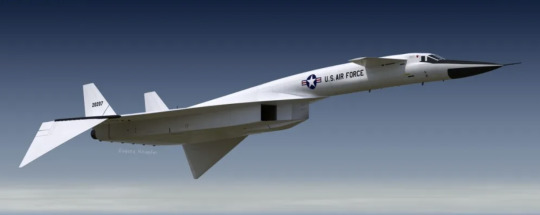
You get that design from the "momentum principle": if the fuselage was symmetric you'd get neutral lift, while if you leave just the lower half of it, it will deflect air downwards but not upwards, creating lift.

And the same principle also explains why the wingtips fold down: it takes some of the air that was deflected sideways and redirects it downwards for additional lift.

104 notes
·
View notes
Text
Thursday Check-In Post (Week 2)

For this semester I am super excited to create content and become more knowledgeable about the web writing space. It feels a bit overwhelming with so much work on my plate between my five other classes and this one but I want to set myself up for success. A big part of that is asking questions as things come up to keep it clear. One thing I was unclear about was specific formatting. Is there a specific structure we should follow or id up to personal style? Everything is a design choice, but is there preferences a professor would prefer for grading our posts?
Also, after completing the reading I was still confused by the meaning of this sentence in the 3 principles of design. “Selecting images and words and text shapes that meet discourse community expectations for the audience within that group will increase positive feelings of good user experience.” I am having a hard time grasping what discourse means and in line with community expectations, what does that actually look like? I am hoping to better understand these topics to use in my toolbox throughout the course. @npfannen
4 notes
·
View notes
Text
I just saw a job description with a fascinating set of technical red flags:
Milliseconds matter! Performance is key! Optimizing database access, algorithms, choosing the right data structures, in general working to design performant systems.
This is a C# job. Usually, if optimization actually really matters in a piece of software, it would be written in C or C++, or maybe Go, not C#. So this means that either they used the wrong language for their stack (and have no intent to switch) or they don't know what actually makes good software good and just put this on the job description to make it look sharp.
We write code from the ground up. We don’t use a lot of frameworks, packages, etc. Not a lot of macro-level stuff. Core software engineering chops is what we’re looking for.
Translation: "We like to waste a lot of time reinventing the wheel".
Our suite of systems is vast and varied. There are web services (REST, SOAP, hybrid), windows services, daemons, websites, libraries, command line tools, windows apps.
"Our services have no consistent interface, or guiding design principles, and getting them to interact with each other sensibly will be a nightmare."
We have plans to redesign several of the older systems, which will be a lot of fun.
"Our legacy codebase is so bad that we finally decided we couldn't fix it and instead are throwing it all out and starting over again."
There are a lot of system interfaces, both within our own suite as well as across teams in the organization. Plenty of opportunities for collaboration with a lot of smart people.
"We mentioned earlier that our services have no consistent interface, but have we also mentioned that there are a lot of them?"
We have immediate needs for refactoring and several enhancements to allow us to scale up to meet increased loads.
"The technical debt is so bad that even management thinks it's time to refactor."
We work with LOTS of data (many, many TB) & it comes fast! Scalability & heavy transactional loads, heavy reporting are common challenges for us. We solve a lot of interesting and tricky problems. Often not your typical collect/save/display that you get at other places. Not snapping into established frameworks. Working across tiers as required. Opportunities for more advanced coding.
Normally this wouldn't be a red flag, but when combined with the rest of the job description, it just really hammers home the point that it's going to be a huge pain in the ass to work with this codebase and a lot of "clever" hacky shit will probably be required.
2 notes
·
View notes
Text
The Future of Television: an Introspection
I think we are at a transition point
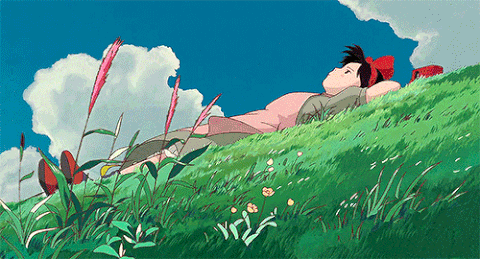
This story begins in the Los Angeles airport, LAX. Earlier that day, I had a flight scheduled to fly from Burbank to Cincinnati (with a layover in Atlanta) to visit my parents. The flight, unfortunately, was delayed due to weather conditions, so the airline booked me for a or straight flight to CVG. After making my way over to LAX, I noticed the TV near a bar near where I was sitting- and something caught my eye.
An advertisement: for Disney+, Hulu, and Max for $17 with ads, and $30 with ads.
First of all, that's too inexpensive. With previous cable packages exceeding $100 a month, having 3 of the largest and most well known streaming services together in a single deal for less than a third of that previous price is simply unsustainable. My guess – is this deal is introductory pricing to get people used to this bundle as a norm, after which the price can slowly increase without much customer loss.
Secondly, why? Disney and Hulu makes sense, Disney owns Hulu, but Max? Max is owned by WarnerBros. Discovery, one of the largest companies in the video streaming space, and Max itself is a direct competitor to Disney+. What would they have to benefit from cooperation?
Here’s what they have to benefit:
Firstly - some business terms
A knock on the door is heard. Claire opens the door. BYSTANDER enters looking confused. Bystander: I thought this essay was about television? Claire: You thought making television was about making television? Bystander shrugs. Claire: Unfortunately... it's about the money >:3
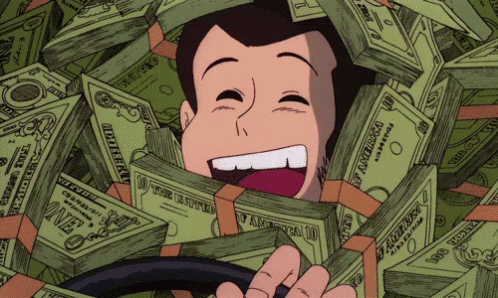
Economies of scale is an economic principle indicating that the more you produce of something, the less it costs per item to produce. If I want to make 1 copy of The Glass Scientists by Sage Cotugno (a very good graphic novel you should read ( ᵔ ⩊ ᵔ )), it might take me 5-10 hours to print out the pages, bind them together, cut out the cover, glue the whole thing, etc.
If the cost of the materials is, let’s say, $7.00, but it takes 7 hours to make (at $25 an hour, because I’m an expensive bitch (¬‿¬ )) - then it costs this hypothetical company $182 to make this one book. That means you as a consumer would be charged around $200 - very expensive (>﹏<).
On the other hand, if I want to make 10,000 copies of this book, and I have $100,000 dollars lying around (as one does), I can buy an industrial book printing machine for $30,000, and even with 30 hours of labor, it still costs:
Labor - 30 hours of work * $25/hr = $750 Materials - $7 per book * 10,000 books = $70,000 Cost of Equipment - $30,000 Total Cost - $100,750 Cost per book - $100,750 / 10,000 books = $10.075
about $10 per book, which, in terms of individual cost, is a huge difference from our first estimate of $182.
Now, to be frank, these numbers are all bogus. I have no idea how much it costs to make a book - but the principle is the same with real numbers.
When your production scales up, your cost per product goes down. Massive corporations don’t build megafactories because they like the aesthetic: they do it because it saves them money.
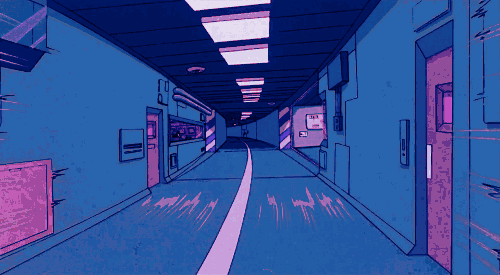
Now, this makes sense for physical products like books, but it also applies to intangible goods, like software, or web design, or streaming technology infrastructure (ding ding ding).
From a business standpoint it doesn’t make sense for 6 different companies to develop 6 different compression algorithms, and have 6 different interfaces to connect to 6 different data centers to do exactly the same thing: take an uncompressed ISO file, compress it for streaming, and send it to your device.
I personally think this is why we are seeing a lot of corporate consolidation in our current era of streaming – because, from a distributor perspective, it makes sense for all companies in the space to work together - or at least consolidate into a much smaller number of players.
But that’s only one-half of the story:
Seeing these companies merge and bundle was not what originally got me thinking about this whole, media market structure thing.
What got my gears turning was something a lot closer to what I actually care about.
Over the past couple of years, it’s been very disheartening to see many wonderful and amazing series get cut short for seemingly no reason.
I love Inside Job. Shion Takeuchi’s sense of comedy, combined with the fondness and criticalness the show has for Reagan makes her growth feel so authentic! I love seeing what she's doing, when she is in over her head, figuring out what she wants out of life. It’s amazing and funny and incredible.
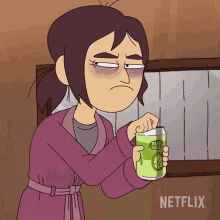
I love Scavenger’s Reign! Joseph Bennett and Charles Huettner and everyone on the crew do such an amazing job at crafting this eerie fascination for biology. I can totally see the show, and Joseph Bennett’s narrative style, becoming seminal in science fiction later on. Amazing work.
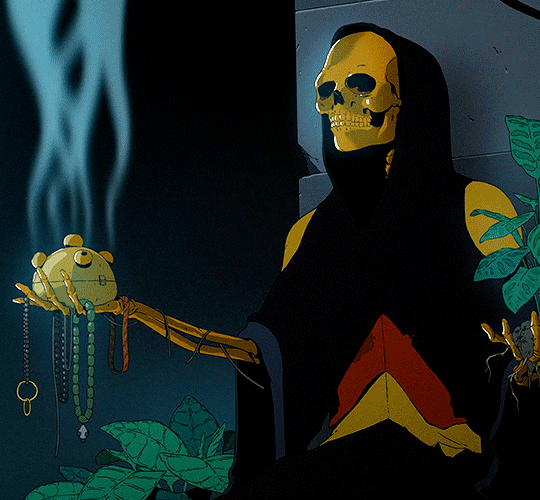
The Owl House! An amazing Disney show created by an amazing person loved dearly by many amazing people. (you can also replace the word amazing with the word gay and it still works! (o^ ^o))
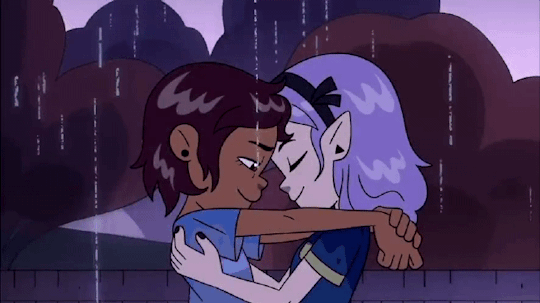
Inside Job wasn't renewed for a season 2 by Netflix. Owl House had its season 3 cut short. Scavenger’s Reign wasn’t renewed by Warner Bros. Discovery, was brought over to Netflix, and then was canceled by Netflix!
To be honest, I don’t know everything about television production. I want to learn and I want to discover but at this point in time I don’t have a clear answer of why these shows were canceled.
Dana Terrace has stated that The Owl House was canceled without her input, which is incredibly disheartening to hear.
Netflix hasn’t made an official statement about the reasons for Inside Job being canceled or Scavenger’s Reign - but I have a theory about what’s going on
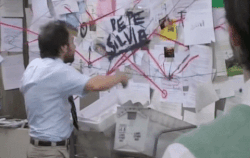
Remember when I mentioned economies of scale? Well, there’s an inverse economic principle called diseconomies of scale. Diseconomies of scale indicates that at a certain scale, as production gets larger, the cost per item gets more expensive, rather than less expensive. This can be due to a whole basket of factors, from increasing organizational costs, to transportation and distribution costs, etc. It’s the reason why there isn’t 1 factory that makes all the paper towels in the world. If economies of scale were an absolute rule, that single factory would be the standard, but it’s not. There are certain economic advantages to having multiple smaller factories rather than 1 giant factory (transportation, distribution, etc.).
There are economic reasons for a company to scale up production, but there are also economic reasons for a company to scale down or split production. When companies are at an equilibrium between economies of scale and diseconomies of scale, they are operating at their maximum market efficiency.
So, how does this apply to streaming companies?
Well, I mentioned before my theory that streaming companies are consolidating due to economies of scale from a distributor perspective, but these companies aren’t just acting as content distributors, they’re also acting as content producers.
Ye Old Media Wisdom Having a single company as a distributor and a producer is a bad idea. -me just now :)
Here’s why:
One of the aspects of diseconomies of scale is the problems with large organization. As a company gets larger, it becomes more and more difficult for people to communicate up and down the ladder and to communicate with different departments across the company. If your company is making something easily measured, like paper towels, your company can be both large and successful (like P&G) because the measurements of what makes a paper towel valuable for the consumer and for the company are easily communicated between teams. If a team is able to make a paper towel 10% more absorbent with a 2% increase in weight, it’s easy to communicate that possible change to a higher up - and their decision, whether to proceed with that change or not, will be made with most of the important details needed for that decision, primarily because those details are easy to communicate.
Making entertainment, especially animated entertainment, is something that is much more complex, subjective, and harder to communicate than paper towels. Different series appeal to different people, different shows have different voices, and being able to communicate the benefits of a series to a friend is challenging, let alone an executive 3 organization levels up. Additionally, making an impactful and amazing series takes risks! All great storytelling is communicating a perspective that is unique and engaging, but to make something unique is by definition to make something new, which requires risk. Larger companies are more risk averse than smaller companies: they have more to lose, are harder to change, and adapt less quickly. For a company whose primary purpose is to make stories that people engage with, being larger is, unfortunately, antithetical to that goal. People who want to make something different deal with more red tape, more bureaucracy, and more people their story has to please. It becomes harder and harder to make something that is new and impactful - to put it another way, it becomes harder to make something successful.
In my opinion, many of the recent releases of Disney feel… generic. Lightyear, Strange World, Wish - these films are by no means made by people without skill or character, but if those people are not allowed to take risks, if they’re not allowed to make anything outside the lowest common denominator of opinions, then the perspective these films convey is destined to be bland and uninteresting.
In my opinion, this is why companies like Riot / Fortiche and Sony Pictures Animation have been kicking ass recently. Spider-Verse, Mitchells and Arcane are amazing and seem to have the support and space they need. Since Riot and Sony Pictures Animation aren’t distributors, they don’t have the same pressure to become a larger company themselves. They can stay the size they want and continue to produce animation at a quality and risk level they are comfortable with.
I don’t know exactly what’s going on inside these companies, there might be other factors that contribute to their success - but I do know that making TV is hard. Making anything at a studio level is hard. Many people have to spend months of their lives working, communicating, and trying to discover what this thing they’re working on is. When people working on these series not only make something, but make something incredible - and after all that, are not be supported?
well, that’s just bad business
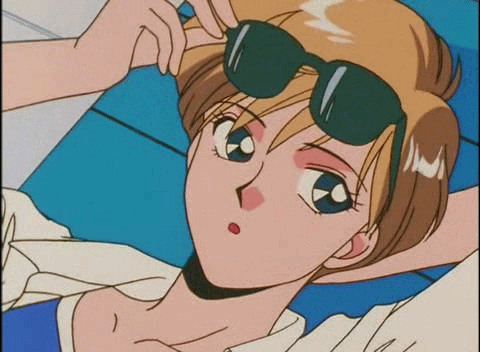
Epilogue
So where do we go from here?
Well if I were in charge of the largest media corporations on the planet, I’d say: spin off your animation production companies into their own entities and act, primarily, as the best distributor on the market. This will allow for you to remain as the larger corporate entity you want to be but remove the bureaucratic restrictions on production companies. Additionally, it gives the distributor more choices! Now they don’t only stream your own content, they can stream anyone else’s if they want! If another, better player comes into town, making more popular media, they can stream their shows instead. Production companies get the freedom to make great things, distributors get the structure and size that they need, and consumers, because of the competition between the two, get the best deal for their money.
This is what cable TV was in my opinion: one or 2 big distributors offering the same service, and many smaller production companies making the things we love.
Ideal market structure for media distributors, I think, is 1 or 2 big companies.
Ideal market structure for media producers, however, is many smaller companies.
It will take time, but I think we’ll get to this market structure eventually – or something new might come along, who can say (ᵔ ⩊ ᵔ)
In the meantime, I wish a tremendous amount of support to the artists and individuals who make the animation and series that we all love.
Y���all are why any of this exists in the first place – don’t forget that.
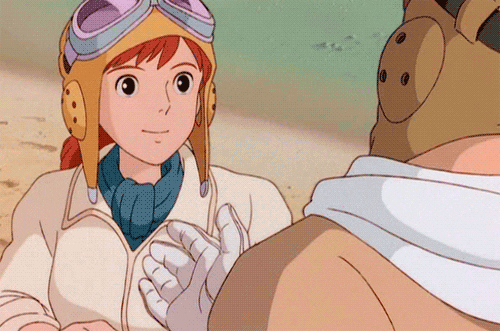
-Claire
4 notes
·
View notes
Text
Mastering Data Structures: A Comprehensive Course for Beginners
Data structures are one of the foundational concepts in computer science and software development. Mastering data structures is essential for anyone looking to pursue a career in programming, software engineering, or computer science. This article will explore the importance of a Data Structure Course, what it covers, and how it can help you excel in coding challenges and interviews.
1. What Is a Data Structure Course?
A Data Structure Course teaches students about the various ways data can be organized, stored, and manipulated efficiently. These structures are crucial for solving complex problems and optimizing the performance of applications. The course generally covers theoretical concepts along with practical applications using programming languages like C++, Java, or Python.
By the end of the course, students will gain proficiency in selecting the right data structure for different problem types, improving their problem-solving abilities.
2. Why Take a Data Structure Course?
Learning data structures is vital for both beginners and experienced developers. Here are some key reasons to enroll in a Data Structure Course:
a) Essential for Coding Interviews
Companies like Google, Amazon, and Facebook focus heavily on data structures in their coding interviews. A solid understanding of data structures is essential to pass these interviews successfully. Employers assess your problem-solving skills, and your knowledge of data structures can set you apart from other candidates.
b) Improves Problem-Solving Skills
With the right data structure knowledge, you can solve real-world problems more efficiently. A well-designed data structure leads to faster algorithms, which is critical when handling large datasets or working on performance-sensitive applications.
c) Boosts Programming Competency
A good grasp of data structures makes coding more intuitive. Whether you are developing an app, building a website, or working on software tools, understanding how to work with different data structures will help you write clean and efficient code.
3. Key Topics Covered in a Data Structure Course
A Data Structure Course typically spans a range of topics designed to teach students how to use and implement different structures. Below are some key topics you will encounter:
a) Arrays and Linked Lists
Arrays are one of the most basic data structures. A Data Structure Course will teach you how to use arrays for storing and accessing data in contiguous memory locations. Linked lists, on the other hand, involve nodes that hold data and pointers to the next node. Students will learn the differences, advantages, and disadvantages of both structures.
b) Stacks and Queues
Stacks and queues are fundamental data structures used to store and retrieve data in a specific order. A Data Structure Course will cover the LIFO (Last In, First Out) principle for stacks and FIFO (First In, First Out) for queues, explaining their use in various algorithms and applications like web browsers and task scheduling.
c) Trees and Graphs
Trees and graphs are hierarchical structures used in organizing data. A Data Structure Course teaches how trees, such as binary trees, binary search trees (BST), and AVL trees, are used in organizing hierarchical data. Graphs are important for representing relationships between entities, such as in social networks, and are used in algorithms like Dijkstra's and BFS/DFS.
d) Hashing
Hashing is a technique used to convert a given key into an index in an array. A Data Structure Course will cover hash tables, hash maps, and collision resolution techniques, which are crucial for fast data retrieval and manipulation.
e) Sorting and Searching Algorithms
Sorting and searching are essential operations for working with data. A Data Structure Course provides a detailed study of algorithms like quicksort, merge sort, and binary search. Understanding these algorithms and how they interact with data structures can help you optimize solutions to various problems.
4. Practical Benefits of Enrolling in a Data Structure Course
a) Hands-on Experience
A Data Structure Course typically includes plenty of coding exercises, allowing students to implement data structures and algorithms from scratch. This hands-on experience is invaluable when applying concepts to real-world problems.
b) Critical Thinking and Efficiency
Data structures are all about optimizing efficiency. By learning the most effective ways to store and manipulate data, students improve their critical thinking skills, which are essential in programming. Selecting the right data structure for a problem can drastically reduce time and space complexity.
c) Better Understanding of Memory Management
Understanding how data is stored and accessed in memory is crucial for writing efficient code. A Data Structure Course will help you gain insights into memory management, pointers, and references, which are important concepts, especially in languages like C and C++.
5. Best Programming Languages for Data Structure Courses
While many programming languages can be used to teach data structures, some are particularly well-suited due to their memory management capabilities and ease of implementation. Some popular programming languages used in Data Structure Courses include:
C++: Offers low-level memory management and is perfect for teaching data structures.
Java: Widely used for teaching object-oriented principles and offers a rich set of libraries for implementing data structures.
Python: Known for its simplicity and ease of use, Python is great for beginners, though it may not offer the same level of control over memory as C++.
6. How to Choose the Right Data Structure Course?
Selecting the right Data Structure Course depends on several factors such as your learning goals, background, and preferred learning style. Consider the following when choosing:
a) Course Content and Curriculum
Make sure the course covers the topics you are interested in and aligns with your learning objectives. A comprehensive Data Structure Course should provide a balance between theory and practical coding exercises.
b) Instructor Expertise
Look for courses taught by experienced instructors who have a solid background in computer science and software development.
c) Course Reviews and Ratings
Reviews and ratings from other students can provide valuable insights into the course’s quality and how well it prepares you for real-world applications.
7. Conclusion: Unlock Your Coding Potential with a Data Structure Course
In conclusion, a Data Structure Course is an essential investment for anyone serious about pursuing a career in software development or computer science. It equips you with the tools and skills to optimize your code, solve problems more efficiently, and excel in technical interviews. Whether you're a beginner or looking to strengthen your existing knowledge, a well-structured course can help you unlock your full coding potential.
By mastering data structures, you are not only preparing for interviews but also becoming a better programmer who can tackle complex challenges with ease.
3 notes
·
View notes
Note
for the 40th celebration tmnt ask game: 7 and 27?
Yay! Thank you!
7.) Which iteration is your favorite?
You never forget your first loves, do you?
Deep in my heart, the Jim-Henson-designed 1990's TEENAGE MUTANT NINJA TURTLES the Movie (tm) IRL turtle costumes with actual top-tier martial artists inside them are my boys.
My mental picture of the guys has shifted this way and that over the years, but at its core, I start with the 1990s Live Action Movie turtles.
Also they're such good boys? They're so innocent? They're trying so hard? They desperately want to save their father? They're caught up in a web of history that they do not fully know and cannot comprehend until their final climactic battle? And they're willing to die for each other? Sacrifice anything to hold onto their family? Love is their deepest guiding principle?
I just treasure them. Precious cinnamon rolls. Too good for this world. Too pure.






(2012!TMNT are my second favs.)

27.) What is something you love to see in TMNT art/fics?
I love to see some adrenaline-fueled, dumbfuck, mad lad, light-everything-on-fire, boy time bullshit. Is it an action packed fight? Is it mind-bending ninjutsu prowess? Is it the four of them road-testing Donatello's newest rocket-skates down the sheet glass windows of the Central Park Tower? (Last one to pull their parachute cord without hitting the pavement wins. What are you, chicken?)
I want brothers being the BROTHEREST. Not "I love you, man!" (though that's important,) but "I dare you to eat that entire ghost pepper pizza shake before practice. (Chug! Chug! Chug!)"
I want them to be little gremlins. Utterly unhinged chaos children. I love to see them play. No rules. No limits.
Just, "Yo! Dudes! Donnie said he's got a bunch of new explosives to test. Grab some stuff you wanna blow up and let's go!"
Let them be idiots, Your Honor.

5 notes
·
View notes
Text
The Role of Color Theory in Web Design

In the digital age, web design has evolved into a sophisticated art that requires a deep understanding of various elements to create visually appealing and effective websites. Among these elements, color theory stands out as a crucial aspect that significantly influences user experience and behavior. Understanding and applying color theory in web design can help in creating websites that not only look good but also convey the right message and emotions to the audience. Here’s a closer look at the role of color theory in web design.
What is Color Theory?
Color theory is a body of practical guidance to color mixing and the visual effects of specific color combinations. It encompasses a multitude of definitions, concepts, and design applications – enough to fill several encyclopedias. However, there are three basic categories of color theory that are logical and useful: the color wheel, color harmony, and the context of how colors are used.
The Color Wheel: The color wheel is a circular diagram of colors arranged by their chromatic relationship. Primary colors (red, blue, yellow), secondary colors (green, orange, purple), and tertiary colors (the mix of primary and secondary colors) are laid out in a wheel to illustrate the relationship between colors.
Color Harmony: Color harmony refers to the pleasing arrangement of colors. Harmonious color schemes create a balance that is aesthetically pleasing to the eye. Common schemes include complementary (opposite colors on the wheel), analogous (colors next to each other), and triadic (three colors evenly spaced around the wheel).
Color Context: How colors behave in relation to other colors and shapes. This aspect of color theory involves understanding how colors influence each other when juxtaposed and how they affect the viewer’s perception and feelings.
The Importance of Color Theory in Web Design
Establishes Brand Identity: Colors are powerful branding tools. They can convey a brand’s message and values. For instance, blue often represents trust and professionalism, making it a popular choice for corporate websites, while green is associated with nature and health, ideal for environmental and wellness sites.
Enhances User Experience: Proper use of color can guide users through a website, making it easier to navigate. Colors can highlight important elements, such as call-to-action buttons, links, and navigation menus, helping users to quickly find what they need.
Evokes Emotions: Different colors evoke different emotions and responses. Warm colors like red and orange can create a sense of urgency or excitement, while cool colors like blue and green can be calming and reassuring. Understanding these emotional triggers can help designers create a desired mood and influence user behavior.
Improves Readability and Accessibility: The right color combinations can improve readability and ensure that the content is accessible to all users, including those with visual impairments. High contrast between text and background is crucial for readability, and tools like color contrast checkers can help ensure accessibility standards are met.
Directs Attention: Colors can be used strategically to draw attention to specific areas of a website. For example, using a contrasting color for a call-to-action button makes it stand out, encouraging users to click on it.
Applying Color Theory in Web Design
Choose a Color Scheme: Start with a base color that reflects the brand’s personality and message. Use color harmony principles to choose complementary, analogous, or triadic color schemes that work well together.
Test Color Combinations: Use tools like Adobe Color or Coolors to experiment with different color combinations. These tools help in visualizing how different colors interact and ensuring they create the desired effect.
Consider Cultural Differences: Colors can have different meanings in different cultures. For instance, white is associated with purity in Western cultures but can represent mourning in some Eastern cultures. It’s important to consider the cultural context of your target audience.
Maintain Consistency: Consistency in color use across the website is essential for a cohesive and professional look. Stick to the chosen color palette and apply it uniformly across all pages and elements.
Use Color Psychology: Apply the principles of color psychology to influence user behavior. For example, use red for urgency in clearance sales, blue for trustworthiness in financial services, and green for eco-friendliness in environmental initiatives.
Ensure Accessibility: Use high contrast colors to ensure text is readable and the site is accessible to all users. Tools like the WebAIM Color Contrast Checker can help verify that your color choices meet accessibility standards.
Conclusion
Color theory is an essential component of web design that can greatly impact the effectiveness of a website. By understanding and applying the principles of color theory, web designers can create visually appealing, emotionally engaging, and highly functional websites. At CreationWebs, we harness the power of color theory to help our clients create websites that not only look great but also drive user engagement and achieve business goals. Partner with us to leverage the full potential of color in your web design projects.
Visit Out Website : www.creationwebs.com
2 notes
·
View notes
Text
Interlude: Space and Time
As many have said before, Space is often associated with visual art, and Time is associated with music. That said, some forms of each medium can be said to have more influence from the opposite Aspect. Take photography, for example: a visual art that is nonetheless closely associated with Time. If you're a fan of Life is Strange, you may recall Mr. Jefferson citing filmmaker Alfred Hitchcock for the phrase "little pieces of time" to describe film—or, perhaps, photography. Now, I couldn't find a damn thing on the web that attributes a quote like that to Hitchcock, and I'm not going to take the word of a man who says "selfie-expression" as gospel. That said, it's a perfect way to describe Time's association with photography. Time is concerned with moments, distinct spaces in each timeline which can be occupied and then manipulated by a Time player. So, although photography is a visual medium, the principles of Time have a lot more influence.
On the other hand, if you've ever been to a Catholic Mass—one where the whole congregation sings the hymns together with the choir—recall how the music and chanting grew to fill the entire space, how each arpeggiated chord extended from the mouths of the faithful and seemed to echo from every corner. Acoustics is a branch of physics which describes how sound moves through a space. Knowledge of acoustics is vital when designing a space for optimal sound quality, whether it's a church, concert venue, theatre, et cetera. It's important to note that physics and theatre performance—in particular, the stage and setting—are also closely associated with Space. By using principles of acoustics, one can ensure that the right sounds are amplified, sharpened, or sustained through an echo, while filtering out undesired ones. The Time Aspect is also closely related to technology, as well as repetition, so it's not unusual to see Dave modifying samples in his music, or Aradia's association with the music box. Space, on the other hand, is associated with organic sounds and symbols—the croak of a frog, for example, or Jade's ability to encourage her plants to grow by playing music for them.
It's important that one understands both their Aspect and its opposite. Without this deeper knowledge and appreciation, players risk becoming obliterated by the most negative qualities of their Aspect. Equius refused to rise up against authority and take control of his place in the narrative, so he was swallowed up by the Void and became largely irrelevant to the big picture. Gamzee even used his indigo blood to omit key information in Rose's journal, before it made its lengthy journey through space and time. Engaging with Time while failing to appreciate Space means that a Time player will struggle to see the bigger picture, always rushing from moment to moment and judging each without its proper context. They want to be present for everything, to have a hand in shaping fate—much like an overzealous Light player, who feels they might wither without the spotlight, or the self-obsessed Heart player, whose Main Character Syndrome can easily become terminal. (These three Aspects are next to each other in the Aspect Wheel for good reason.) In the end, they'll likely burn themselves out from the effort. Meanwhile, a Space player who neglects Time risks relinquishing their ability to impose their will upon the universe, favoring passive observation and failing to act when they're needed most. Like an overly-cerebral Mind player, paralyzed by choice, or a sullen Void player, unable to break the surface of an ocean of doubt, a Space player who has receded from responsibility will be a whisper beneath the waves. Drowning, after all, is actually a deceptively silent affair.
23 notes
·
View notes
Text
Top Courses for Aspiring Developers: Elevate Your Skills and Career
Nowadays everyone wants to enhance their skills and career. Everyone wants to improve their skills and take their career forward. You want to improve their skill and take your software development career to the next level.
Today’s tech-driven world, aspiring developers are in high demand. Here’s a guide to some of the top courses designed to elevate your skills and boost your career prospects in the field of software development. Developers use web development languages to help create dynamic web pages. The most common coding languages include Javascript, Python and C. we must constantly update our skills. We should assume good skills that will take our career forward. In this article, we will suggest courses that can help to make software developers.
1. Full-Stack Web Development
This course covers everything from front-end technologies like HTML, CSS, and JavaScript to back-end development with Node.js and Express. It’s ideal for those who want to become proficient in both client and server-side programming.
2. Data Science and Machine Learning
This specialization includes courses on machine learning, data mining, and data analysis. It provides a deep dive into algorithms, statistical methods, and practical applications.
3. Cloud Computing
This course prepares you for the AWS Certified Solutions Architect exam. It covers designing distributed systems, deploying scalable applications, and working with AWS services.
4. Mobile App Development
This series of courses is designed for aspiring iOS developers. It covers Swift programming, user interface design, and app development practices.
5. Cybersecurity
This specialization covers essential cybersecurity concepts, including risk management, cryptography, and network security. It’s designed for those interested in protecting systems and data.
6. Game Development
This specialization covers game design principles, development processes, and interactive media creation. It includes courses on Unity and Unreal Engine, two of the most popular game development platforms.
7. Software Engineering
This course provides a comprehensive overview of software engineering principles, including design patterns, testing, and project management.
8. DevOps
This course introduces key DevOps concepts such as continuous integration, continuous delivery, and infrastructure as code. It’s ideal for developers looking to improve collaboration between development and operations.
By identifying the right courses and doing those courses, we can follow the path of success. As you consider the courses to take, we should do the courses in which we are interest.
Top Courses for Aspiring Developers: Elevate Your Skills and Career
Nowadays everyone wants to enhance their skills and career. Everyone wants to improve their skills and take their career forward. You want to improve their skill and take your software development career to the next level.
Today’s tech-driven world, aspiring developers are in high demand. Here’s a guide to some of the top courses designed to elevate your skills and boost your career prospects in the field of software development. Developers use web development languages to help create dynamic web pages. The most common coding languages include Javascript, Python and C. we must constantly update our skills. We should assume good skills that will take our career forward. In this article, we will suggest courses that can help to make software developers.
1. Full-Stack Web Development
This course covers everything from front-end technologies like HTML, CSS, and JavaScript to back-end development with Node.js and Express. It’s ideal for those who want to become proficient in both client and server-side programming.
2. Data Science and Machine Learning
This specialization includes courses on machine learning, data mining, and data analysis. It provides a deep dive into algorithms, statistical methods, and practical applications.
3. Cloud Computing
This course prepares you for the AWS Certified Solutions Architect exam. It covers designing distributed systems, deploying scalable applications, and working with AWS services.
4. Mobile App Development
This series of courses is designed for aspiring iOS developers. It covers Swift programming, user interface design, and app development practices.
5. Cybersecurity
This specialization covers essential cybersecurity concepts, including risk management, cryptography, and network security. It’s designed for those interested in protecting systems and data.
6. Game Development
This specialization covers game design principles, development processes, and interactive media creation. It includes courses on Unity and Unreal Engine, two of the most popular game development platforms.
7. Software Engineering
This course provides a comprehensive overview of software engineering principles, including design patterns, testing, and project management.
8. DevOps
This course introduces key DevOps concepts such as continuous integration, continuous delivery, and infrastructure as code. It’s ideal for developers looking to improve collaboration between development and operations.
By identifying the right courses and doing those courses, we can follow the path of success. As you consider the courses to take, we should do the courses in which we are interest.
2 notes
·
View notes
Text
AGARTHA Aİ - DEVASA+

In today's digital age, a well-designed website is essential for success, but the cost of professional web design can often be a barrier for many businesses. Fortunately, affordable web design services have emerged as a viable solution, ensuring that everyone—from startups to established small businesses—can establish an impressive online presence without breaking the bank. This blog post will explore the various aspects of affordable web design services, highlighting what to look for in a reliable website service, the importance of responsive web design, and how budget-friendly options can specifically cater to the unique needs of small businesses.
Affordable web design services
In today’s digital landscape, affordable web design services have become essential for businesses of all sizes. With an increasing number of consumers turning to the internet for their needs, having a professional and attractive website is more critical than ever. Many small businesses and startups often worry that they cannot afford high-quality web design, but there are plenty of options available that offer both quality and cost-effectiveness.
One of the main advantages of choosing affordable web design services is the ability to find packages that fit various budgets without sacrificing quality. Many web design agencies understand the needs of small businesses and offer tailored solutions that ensure a professional presentation without overwhelming financial commitments. This is especially beneficial for startups that are eager to establish a digital presence without breaking the bank.
Moreover, many affordable web design services provide flexibility in their offerings, allowing clients to select features that meet their specific requirements. From simple informational websites to more complex e-commerce solutions, the variety available in budget-friendly web design ensures that every business can find a service that aligns with its goals and vision. Investing in affordable web design not only enhances a brand's credibility but also helps reach a wider audience effectively.
Website service
In today's digital age, having a robust website service is essential for both businesses and individuals. A well-designed website serves as the online face of a company and is often the first point of contact for potential customers. Investing in quality website service can significantly enhance your online presence and build trust with your audience.
Choosing the right website service provider is crucial. Look for companies that offer customized solutions tailored to your unique needs. This ensures that the website not only looks good but also functions effectively, providing an optimal user experience. A reliable website service provider should provide ongoing support and maintenance to keep your site running smoothly.
Moreover, an effective website service should prioritize SEO optimization, ensuring that your site ranks well in search engine results. This is vital as higher visibility leads to increased traffic and potential sales. Remember, a great website is more than just beautiful design; it's about delivering a seamless user experience
Responsive web design
Responsive web design is an essential approach to creating websites that provide an optimal viewing experience across a wide range of devices. With the increase in mobile device usage, it has become crucial for businesses to ensure that their websites function seamlessly on smartphones, tablets, and desktops. Designing with responsiveness in mind leads to a more user-friendly experience, which can significantly impact user engagement and conversion rates.
One of the key principles of responsive web design is the use of flexible layouts and grid systems. This allows elements on the page to resize and reposition themselves according to the screen size. By employing CSS media queries, designers can tailor styles for different devices, ensuring that content is displayed appropriately without compromising on aesthetics or functionality.
Moreover, implementing responsive web design is not just beneficial for users, but it also plays a vital role in search engine optimization (SEO). Search engines like Google prioritize mobile-friendly websites in their rankings. Therefore, having a site that is responsive can lead to better visibility in search results, driving more organic traffic to your website.
Affordable web design for small business
In today's digital age, every small business needs a strong online presence to compete effectively. However, finding affordable web designfor small business can be a daunting task for many entrepreneurs. It's essential to strike a balance between quality design and budget constraints.
One of the best ways to achieve this is by opting for responsive web design. This approach ensures that your website not only looks great on desktop but also provides an excellent user experience on mobile devices. Since a significant portion of web traffic comes from smartphones, investing in responsive design is crucial for small businesses seeking to maximize their reach.
There are numerous platforms offering affordable web design packages specifically tailored for small businesses. These services can help you establish a professional look without breaking the bank. By choosing the right designer, you can create a site that reflects your brand and meets your customers' needs while staying within your budget.
46 notes
·
View notes
Text
Modest Swimsuits
Some websites to look up if you want to buy a modest swimsuit this second half of summer. Aka if the humidity lets down enough to finally go swimming.
Shein $

[Image ID: A plus size model wearing a dark blue/teal top with a 3/4 zipper that covers her tummy, shoulders, and flares out at the bottom to cover her rear, and in the same color, a pair of fitted shorts that go to her knees.]
Click HERE to get the swimsuit shown above.
Super cheap in price! Especially compared to what you'd pay at a store.
If you've got wide hips like me you'll need to go into the plus size or curvy section. Otherwise, items will only go up to size 12. Everything from bikini to burkini.
Modlilly $-$$
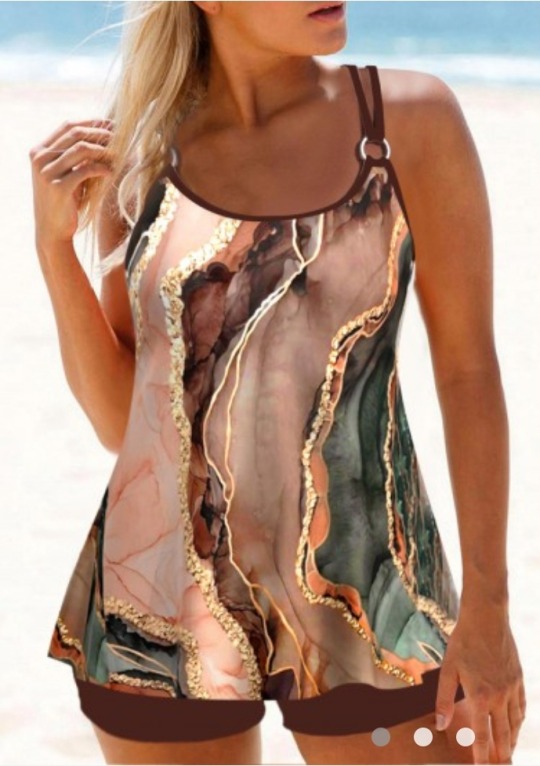
[Image ID: A blonde and tan model wearing a tankini with a watercolor/wavy design in dark brown, light brown/beige, gold, and blue/green. She is also wearing a pair of dark brown short shorts.]
Click HERE to get the swimsuit shown above.
This one was definitely in my top three when was choosing which one to get. Very pretty!
Lots of really cool designs and colors, something I didn't necessarily find in the plus size section on Shein. Lots of tankinis.
Modanisa $$

[Image ID: A tall and slender model wearing dark blue undershirt, loose pants, and swim hijab and over it a white and dark blue swim dress with a leaf pattern that has a high neck, covers her shoulders, and goes down to just below her knees.
Click HERE to get the swimsuit shown above.
This is one of their more expensive swimsuits. Keep in mind there are many as low as $30.
A TON of swimsuits offering half or full coverage. Mostly full. There are a lot of reviews online too.
Sea Secret $$-$$$
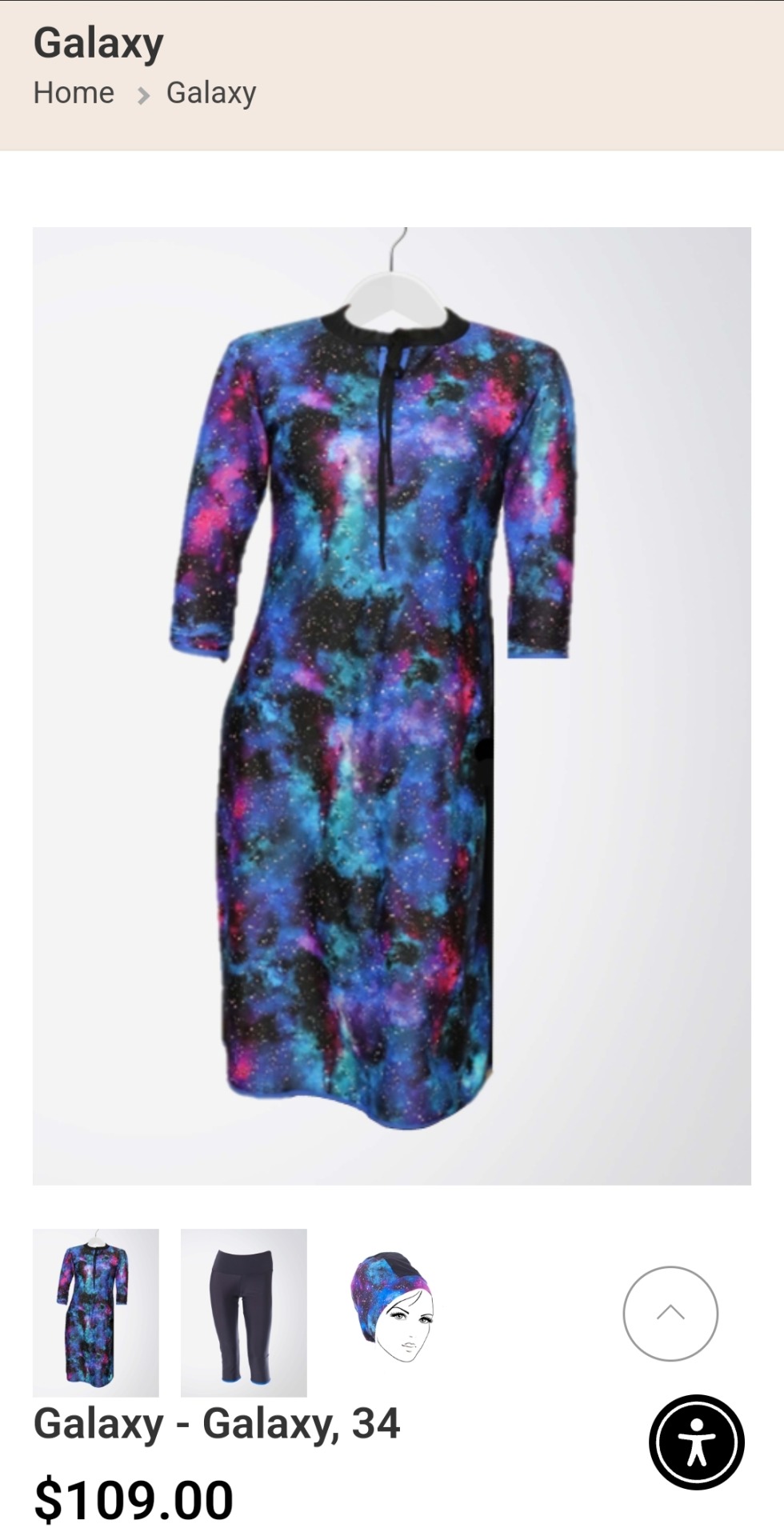
[Image ID: A screenshot of Sea Secret's web page, specifically showing their Galaxy swimsuit dress, which is splotches of black, pink, green, and blue. It comes with black or navy blue leggings and a fabric swim cap/head covering in the same colors as the dress.]
Click HERE to get the swimsuit shown above.
You can shop by body shape! I repeat, you can shop by body shape! I love it. As a pear girlie (wide hips, narrow bust) this is great. 2 and 3 piece swim dress sets with capris and cap which cover collarbone, elbows, and knees according to the Judaic laws of modesty (Tznuit). With shipping, think around $100+
Lanuuk $$-$$$

[Image ID: A more fair-skinned model wears a light powder blue bikini with high-waisted bottoms and a top that has thick straps and provides full coverage of the breasts.]
Click HERE to get the swimsuit shown above.
Lol she is more fair skinned than the other models, but there are folks way more pale than her. I should know. I practically glow when I go out into the sun!
Cute designs, nice colors. Expensive, but they seems to be of good quality from the reviews. There a a lot of copycat designs on Shein for way cheaper.
Bazar Al Haya $$$

[Image ID: A woman with a darker skin tone wears a a swim hijab with an attached shawl that covers her shoulders and breasts. She also wears a mask that covers her mouth and nose. She has on a pair of loose swim pants in navy blue, same as the hijab/shawl. And a swimdress in a geometric design with white, pink, and mavy blue.]
Click HERE to get the swimsuit shown above.
They have a small selection of swimsuits that offer total coverage (including concealment of your curves, according to Islamic principles of modesty.) Mostly plain some have prints.
Does anyone else have any recommendations?
4 notes
·
View notes